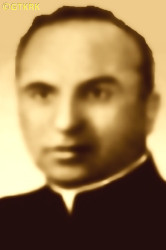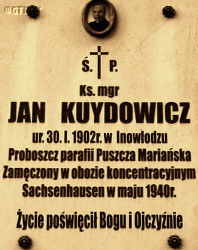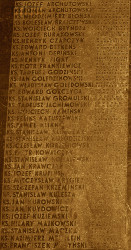Roman Catholic
St Sigismund parish
05-507 Słomczyn
85 Wiślana Str.
Konstancin deanery
Warsaw archdiocese, Poland
full list:
displayClick to display full list

searchClick to search full list by categories
wyświetlKliknij by wyświetlić pełną listę po polsku

szukajKliknij by przeszukać listę wg kategorii po polsku

Martyrology of the clergy — Poland
XX century (1914 – 1989)
personal data
surname
KUYDOWICZ
surname
versions/aliases
KUJDA
forename(s)
John (pl. Jan)
function
diocesan priest
creed
Latin (Roman Catholic) Church RCmore on
en.wikipedia.org
[access: 2014.09.21]
diocese / province
Warsaw archdiocesemore on
en.wikipedia.org
[access: 2013.05.19]
academic distinctions
Sacred Theology MA
date and place
of death
03.05.1940

on Warsaw ‐ Berlin railway line
alt. dates and places
of death
04.05.1940, 06.05.1940
details of death
After German and Russian invasion of Poland in 09.1939 and start of the World War II, after start of German occupation, for the first time arrested by Germans on ok.
12.09.1939, after conducting a public funeral of 4 students of Oblates Congregation and 1 Roman Catholic priest, murdered by Germans, who found themselves in his parish during the chaos of the first days of the war.
Released.
Second time arrested by the Germans on 03.04.1940 when saying Mass during the 40‐hour Eucharistic celebration prior to Lent — together with Fr Henry Figat who was helping him.
Transported to Pawiak prison in Warsaw.
On 02.05.1940 moved out of Warsaw.
Suffocated to death during the transport to KL Sachsenhausen concentration camp, in a overcrowded train car.
cause of death
extermination
perpetrators
Germans
sites and events
KL SachsenhausenClick to display the description, PawiakClick to display the description, «Intelligenzaktion»Click to display the description, GeneralgouvernementClick to display the description, Ribbentrop‐MolotovClick to display the description, Pius XI's encyclicalsClick to display the description
date and place
of birth
30.01.1902Birth certification on:
metryki.genealodzy.pl
[access: 2025.03.15]

Inowłództoday: Inowłódz gm., Tomaszów Mazowiecki pov., Łódź voiv., Poland
more on
en.wikipedia.org
[access: 2022.01.28]
parents
KUJDA Anthony
🞲 ?, ? — 🕆 ?, ?

DUTKIEWICZ Marianne
🞲 ?, ? — 🕆 ?, ?
baptism
02.02.1902Birth certification on:
metryki.genealodzy.pl
[access: 2025.03.15]

Inowłództoday: Inowłódz gm., Tomaszów Mazowiecki pov., Łódź voiv., Poland
more on
en.wikipedia.org
[access: 2022.01.28]
St Michael the Archangel RC church
presbyter (holy orders)
ordination
1929

positions held
c. 1938 – 1940
administrator — Puszcza Mariańskatoday: Puszcza Mariańska gm., Żyrardów pov., Masovia voiv., Poland
more on
en.wikipedia.org
[access: 2021.03.16] ⋄ St Michael the Archangel RC parish ⋄ Mszczonówtoday: Mszczonów gm., Żyrardów pov., Masovia voiv., Poland
more on
en.wikipedia.org
[access: 2021.03.16] RC deanery
c. 1937 – c. 1938
chaplain — Warsawtoday: Warsaw city pov., Masovia voiv., Poland
more on
en.wikipedia.org
[access: 2021.10.09] ⋄ Divine Providence Educational Institute (19 Chełmska Str.), Franciscan Sisters of the Family of Mary CSFFM — also: prefect at schools and member of Warsaw Prefects' Group
c. 1933 – c. 1937
vicar — Warsawtoday: Warsaw city pov., Masovia voiv., Poland
more on
en.wikipedia.org
[access: 2021.10.09] ⋄ St John the Baptist RC archcathedral parish
c. 1932
vicar — Warsawregion known as „Leszno” (around Leszno Str.)
today: Warsaw city pov., Masovia voiv., Poland
more on
en.wikipedia.org
[access: 2021.10.09] ⋄ Nativity of the Blessed Virgin Mary RC parish ⋄ Warsaw‐in‐urbedeanery name
today: Warsaw city pov., Masovia voiv., Poland RC deanery
c. 1929 – c. 1932
student — Warsawtoday: Warsaw city pov., Masovia voiv., Poland
more on
en.wikipedia.org
[access: 2021.10.09] ⋄ theology, Department of Catholic Theology, University of Warsaw [i.e. University of Warsaw (from 1945) / clandestine University (1939‐1945) / Joseph Piłsudski University (1935‐1939) / University of Warsaw (1915‐1935) / Imperial University of Warsaw (1870‐1915)] — postgraduate specialised studies crowned with a Sacred Theology Master's degree
till 1929
student — Warsawtoday: Warsaw city pov., Masovia voiv., Poland
more on
en.wikipedia.org
[access: 2021.10.09] ⋄ philosophy and theology, Metropolitan Theological Seminary
others related
in death
FIGATClick to display biography Henry, CZEMPLIKClick to display biography Ignatius, GEMBIAKClick to display biography Joseph, GLADOSClick to display biography Francis, MUŃKOClick to display biography Francis, ROGOSZClick to display biography Joseph
sites and events
descriptions
KL Sachsenhausen: In Germ. Konzentrationslager (Eng. concentration camp) KL Sachsenhausen, set up in the former Olympic village in 07.1936, hundreds of Polish priests were held in 1940, before being transported to KL Dachau. Some of them perished in KL Sachsenhausen. Murderous medical experiments on prisoners were carried out in the camp. In 1942‐1944 c. 140 prisoners slaved at manufacturing false British pounds, passports, visas, stamps and other documents. Other prisoners also had to do slave work, for Heinkel aircraft manufacturer, AEG and Siemens among others. On average c. 50,000 prisoners were held at any time. Altogether more than 200,000 inmates were in jailed in KL Sachsenhausen and its branched, out of which tens of thousands perished. Prior to Russian arrival mass evacuation was ordered by the Germans and c. 80,000 prisoners were marched west in so‐called „death marches” to other camps, i.e. KL Mauthausen‐Gusen and KL Bergen‐Belsen. The camp got liberated on 22.04.1945. After end of armed hostilities Germans set up there secret camp for German prisoners and „suspicious” Russian soldiers. (more on: en.wikipedia.orgClick to attempt to display webpage
[access: 2018.11.18])
Pawiak: Investigative prison in Warsaw, built by the Russian occupiers of Poland in 1830‐1835. During the Poland partition's period, a Russian investigative prison, both criminal and political. During World War II and the German occupation, the largest German prison in the Germ. Generalgouvernement (Eng. General Governorate). Initially, it was subordinate to the Justice Department of the General Governorate, and from 03.1940 Germ. Sicherheitspolizei und des Sicherheitsdienst (Eng. Security Police and Security Service) of the Warsaw District — in particular the German Secret Political Police Gestapo. c. 3,000 prisoners were kept in Pawiak permanently, of which about 2,200 in the men's unit and c. 800 in the women's unit (the so‐called Serbia) — with a „capacity” of c. 1,000 prisoners. In total, in the years 1939‐1944, c. 100,000 Poles passed through the prison, of which c. 37,000 were murdered in executions — from 10.1943 Pawiak prisoners were murdered in open executions on the streets of Warsaw (sometimes several times a day) — during interrogations, in cells or in a prison „hospital”, and c. 60,000 were taken in 95 transports to concentration camps (mainly KL Auischwitz), other places of isolation or to forced labor. The prison Germans demolished during the Warsaw Uprising in 08‐10.1944. (more on: en.wikipedia.orgClick to attempt to display webpage
[access: 2022.08.17])
«Intelligenzaktion»: German: «Intelligenzaktion» (English: „Intelligence Action”) — a German program of extermination of the Polish elite, mainly the intelligentsia and leadership layers, carried out from the beginning of the occupation in w 09.1939 to 04.1940, mainly in territories directly annexed to Germany, but also in the so‐called Germ. Generalgouvernement (Eng. General Governorate), where it was called «AB‐aktion». In the first phase, immediately after the beginning of the German occupation, during military operations carried out by the Germ. Wehrmacht (Eng. Armed Forces) and the genocidal units of the Germ. Einsatzgruppen (Eng. Operational Groups) of the Germ. Sicherheitspolizei (Eng. Security Police), i.e. SiPo, and Germ. Sicherheitsdienst des Reichsführers SS (Eng. Security Service of the Reichsführer SS), i.e. SD, organized by the Germ. Reichssicherheitshauptamt (Eng. Reich Main Security Office), i.e. RSHA, which followed the troops, carried out under the Germ. Unternehmen „Tannenberg” (Eng. Operation „Tannenberg”) — based on the so‐called Germ. Sonderfahndungsliste (Eng. Special Wanted Lists), i.e. proscription lists of Poles considered particularly dangerous to the Third Reich, prepared by the Zentralstelle II/P (Polen) unit of the German RSHA. Later, implemented by the German civilian occupation authorities and the genocidal unit of the Germ. Volksdeutscher Selbstschutz (Eng. Ethnic Germans Self‐Defense), whose members were Germ. Volksdeutsche (Eng. Ethnic Germans), i.e. representatives of the German minority in Poland. According to various sources, these lists, at the beginning of 09.1939, could have contained the details of 61,000—88,000 „dangerous” Poles — although these figures cannot be confirmed. In total, during this genocide, c. 50,000 teachers, Catholic priests, representatives of the landed gentry, freelancers, social and political activists, and retired military personnel were systematically and methodically murdered. Another 50,000 were sent to concentration camps, where only a negligible percentage survived. (more on: en.wikipedia.orgClick to attempt to display webpage
[access: 2014.10.04])
Generalgouvernement: After the Polish defeat in the 09.1939 campaign, which was the result of the Ribbentrop‐Molotov Pact and constituted the first stage of World War II, and the beginning of German occupation in part of Poland (in the other, eastern part of Poland, the Russian occupation began), the Germans divided the occupied Polish territory into five main regions. In two of them new German provinces were created, two other were incorporated into other provinces. However, the fifth part was treated separately, and in a political sense it was supposed to recreate the German idea from 1915 (during World War I, after the defeat of the Russians in the Battle of Gorlice in 05.1915) of creating a Polish enclave within Germany. Illegal in the sense of international law, i.e. Hague Convention, and public law, managed by the Germans according to separate laws — especially established for the Polish Germ. Untermenschen (Eng. subhumans) — till the Russian offensive in 1945 it constituted part of the Germ. Großdeutschland (Eng. Greater Germany). Till 31.07.1940 formally called Germ. Generalgouvernement für die besetzten polnischen Gebiete (Eng. General Government for the occupied Polish lands) — later simply Germ. Generalgouvernement (Eng. General Governorate), as in the years 1915‐1918. From 07.1941, i.e. after the German attack on 22.06.1941 against the erstwhile ally, the Russians, it also included the Galicia district, i.e. the Polish pre‐war south‐eastern voivodeships. A special criminal law was enacted and applied to Poles and Jews, allowing for the arbitrary administration of the death penalty regardless of the age of the „perpetrator”, and sanctioning the use of collective responsibility. After the end of the military conflict of the World War UU, the government of the Germ. Generalgouvernement was recognized as a criminal organization, and its leader, governor Hans Frank, guilty of war crimes and crimes against humanity and executed. (more on: en.wikipedia.orgClick to attempt to display webpage
[access: 2024.12.13])
Ribbentrop‐Molotov: Genocidal Russian‐German alliance pact between Russian leader Joseph Stalin and German leader Adolf Hitler signed on 23.08.1939 in Moscow by respective foreign ministers, Mr. Vyacheslav Molotov for Russia and Joachim von Ribbentrop for Germany. The pact sanctioned and was the direct cause of joint Russian and German invasion of Poland and the outbreak of the World War II in 09.1939. In a political sense, the pact was an attempt to restore the status quo ante before 1914, with one exception, namely the „commercial” exchange of the so‐called „Kingdom of Poland”, which in 1914 was part of the Russian Empire, fore Eastern Galicia (today's western Ukraine), in 1914 belonging to the Austro‐Hungarian Empire. Galicia, including Lviv, was to be taken over by the Russians, the „Kingdom of Poland” — under the name of the General Governorate — Germany. The resultant „war was one of the greatest calamities and dramas of humanity in history, for two atheistic and anti‐Christian ideologies — national and international socialism — rejected God and His fifth Decalogue commandment: Thou shall not kill!” (Abp Stanislav Gądecki, 01.09.2019). The decisions taken — backed up by the betrayal of the formal allies of Poland, France and Germany, which on 12.09.1939, at a joint conference in Abbeville, decided not to provide aid to attacked Poland and not to take military action against Germany (a clear breach of treaty obligations with Poland) — were on 28.09.1939 slightly altered and made more precise when a treaty on „German‐Russian boundaries and friendship” was agreed by the same murderous signatories. One of its findings was establishment of spheres of influence in Central and Eastern Europe and in consequence IV partition of Poland. In one of its secret annexes agreed, that: „the Signatories will not tolerate on its respective territories any Polish propaganda that affects the territory of the other Side. On their respective territories they will suppress all such propaganda and inform each other of the measures taken to accomplish it”. The agreements resulted in a series of meeting between two genocidal organization representing both sides — German Gestapo and Russian NKVD when coordination of efforts to exterminate Polish intelligentsia and Polish leading classes (in Germany called «Intelligenzaktion», in Russia took the form of Katyń massacres) where discussed. Resulted in deaths of hundreds of thousands of Polish intelligentsia, including thousands of priests presented here, and tens of millions of ordinary people,. The results of this Russian‐German pact lasted till 1989 and are still in evidence even today. (more on: en.wikipedia.orgClick to attempt to display webpage
[access: 2015.09.30])
Pius XI's encyclicals: Facing the creation of two totalitarian systems in Europe, which seemed to compete with each other, though there were more similarities than contradictions between them, Pope Pius XI issued in 03.1937 (within 5 days) two encyclicals. In the „Mit brennender Sorge” (Eng. „With Burning Concern”) published on 14.03.1938, condemned the national socialism prevailing in Germany. The Pope wrote: „Whoever, following the old Germanic‐pre‐Christian beliefs, puts various impersonal fate in the place of a personal God, denies the wisdom of God and Providence […], whoever exalts earthly values: race or nation, or state, or state system, representatives of state power or other fundamental values of human society, […] and makes them the highest standard of all values, including religious ones, and idolizes them, this one […] is far from true faith in God and from a worldview corresponding to such faith”. On 19.03.1937, published „Divini Redemptoris” (Eng. „Divine Redeemer”), in which criticized Russian communism, dialectical materialism and the class struggle theory. The Pope wrote: „Communism deprives man of freedom, and therefore the spiritual basis of all life norms. It deprives the human person of all his dignity and any moral support with which he could resist the onslaught of blind passions […] This is the new gospel that Bolshevik and godless communism preaches as a message of salvation and redemption of humanity”… Pius XI demanded that the established human law be subjected to the natural law of God , recommended the implementation of the ideal of a Christian state and society, and called on Catholics to resist. Two years later, National Socialist Germany and Communist Russia came together and started World War II. (more on: www.vatican.vaClick to attempt to display webpage
[access: 2023.05.28], www.vatican.vaClick to attempt to display webpage
[access: 2023.05.28])
sources
personal:
www.puszcza-marianska.plClick to attempt to display webpage
[access: 2013.02.15], alija.4me.plClick to attempt to display webpage
[access: 2013.02.15], metryki.genealodzy.plClick to attempt to display webpage
[access: 2025.03.15]
bibliographical:
„Big Heart”, Darius Kaczmarczyk, PAX Publishing, 1985, Warsaw
original images:
panaszonik.blogspot.comClick to attempt to display webpage
[access: 2014.01.06], www.polskaniezwykla.plClick to attempt to display webpage
[access: 2014.01.06]
LETTER to CUSTODIAN/ADMINISTRATOR
If you have an Email client on your communicator/computer — such as Mozilla Thunderbird, Windows Mail or Microsoft Outlook, described at WikipediaPatrz:
en.wikipedia.org, among others — try the link below, please:
LETTER to CUSTODIAN/ADMINISTRATORClick and try to call your own Email client
If however you do not run such a client or the above link is not active please send an email to the Custodian/Administrator using your account — in your customary email/correspondence engine — at the following address:

giving the following as the subject:
MARTYROLOGY: KUYDOWICZ John
To return to the biography press below:
 Click to return to biography
Click to return to biography










